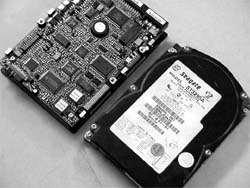More bytes to chew
 ten years ago, a computer hard disk was considered advanced if it could hold about 100 megabytes (millions of bytes) of information. About 10-20 gigabyte (billions of bytes) hard disks are now commonly used in home computers. In fact, the amount of information that can be stored in a memory device has been increasing by about 60 per cent every year for some time now.
ten years ago, a computer hard disk was considered advanced if it could hold about 100 megabytes (millions of bytes) of information. About 10-20 gigabyte (billions of bytes) hard disks are now commonly used in home computers. In fact, the amount of information that can be stored in a memory device has been increasing by about 60 per cent every year for some time now.
With the advent of smaller computing devices, the focus is on increasing the storing capacity of hard discs. Now, researchers at the University of Nebraska, usa, have shown how it is possible to increase the storage capacity of computer hard disks by 1,000 per cent.
In any magnetic medium, be it a computer disc or a magnetic tape, information is stored by the orientation of tiny magnets in the magnetic material. This orientation represents either a 0 or a 1 (the storage is binary).The unit of information is a bit - either a 0 or 1 while a convenient measure of computer memory is a byte or 8 bits.
The magnetic material is usually a thin film of particles that can be oriented by the help of an electromagnet. Most of the tapes and disks use chromium oxides but the high performance devices today use cobalt-based compounds for higher density. Typically, the amount of information that can be stored in a square cm of such a material is 1 gigabit.
The property that governs the maximum amount of information that can be packed in a material is called the coercivity. This is the power of a magnetic material to resist reorientation of its field and it varies from one material to another. To pack more information, the tiny magnets representing the 0s and 1s have to be closer to each other - the area representing one bit of information has to be shrunk.
Since the tiny magnets exert a force on each other also, there is a higher chance that the orientations will change if they are closely packed. This will make the memory unreliable and thus useless. Materials with high coercivity are needed for more densely packed, stable memories. Another property that can influence the information density is the isolation of the magnetic grains in the material. If the grains are better isolated magnetically, then they will be more stable against neighbouring fields that could disorient them.
Now, M Yu and his colleagues of the University of Nebraska, usa , have developed a cobalt-platinum alloy that can be used to enhance the storage density by a huge amount. The alloy is well known for its high coercivity. Particles of the alloy of sizes ranging from 8 and 20 nanometers in size The unit of information is a bit - either a 0 or 1 while a convenient measure of computer memory is a byte or 8 bits.
The magnetic material is usually a thin film of particles that can be oriented by the help of an electromagnet. Most of the tapes and disks use chromium oxides but the high performance devices today use cobalt-based compounds for higher density. Typically, the amount of information that can be stored in a square cm of such a material is 1 gigabit.
The property that governs the maximum amount of information that can be packed in a material is called the coercivity. This is the power of a magnetic material to resist reorientation of its field and it varies from one material to another. To pack more information, the tiny magnets representing the 0s and 1s have to be closer to each other - the area representing one bit of information has to be shrunk.
Since the tiny magnets exert a force on each other also, there is a higher chance that the orientations will change if they are closely packed. This will make the memory unreliable and thus useless. Materials with high coercivity are needed for more densely packed, stable memories. Another property that can influence the information density is the isolation of the magnetic grains in the material. If the grains are better isolated magnetically, then they will be more stable against neighbouring fields that could disorient them.
Now, M Yu and his colleagues of the University of Nebraska, usa , have developed a cobalt-platinum alloy that can be used to enhance the storage density by a huge amount. The alloy is well known for its high coercivity. Particles of the alloy of sizes ranging from 8 and 20 nanometers in size (a nanometer is a billionth of a metre or a millionth of a millimetre) are suspended in a carbon matrix.
The carbon separates and thus insulates the neighbouring magnetic particles allowing for a greater storage density of information. Hard disks made from this material could allow for storage densities of about 10-15 gigabits per square centimetre - about 10 times the storage density of the best magnetic devices currently available (Applied Physics Letters , Vol 75, p3992).in a carbon matrix.
The carbon separates and thus insulates the neighbouring magnetic particles allowing for a greater storage density of information. Hard disks made from this material could allow for storage densities of about 10-15 gigabits per square centimetre - about 10 times the storage density of the best magnetic devices currently available ( Applied Physics Letters , Vol 75, p3992).
